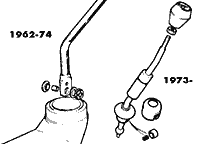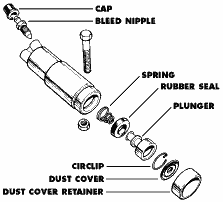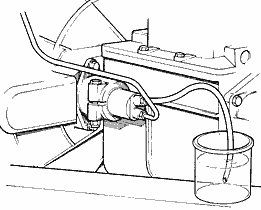Slave Cylinder Replacement
There is good and bad news associated with doing this job. The good is that the repair is extremely easy to accomplish. The bad news is that there are two ways to get at the slave…the hard way (from inside the cockpit) and the harder way (from under the car). This story illustrates the procedure.
Tools Required:
Phillips screwdriver
large flat screwdriver
socket wrenches
open-ended wrench
brake fluid
slave cylinder rebuild kit
DOT4 brake fluid
Optional:
new slave cylinder
Removal
First remove the left seat. This is done by sliding the seat all the way back and taking out the two bolts (7/16″) at the front of the tracks. The rear of the tracks has two bolts that can be reached by sliding the seats all the way forward. Lift out the seat.
All the trim pieces around the transmission tunnel must be removed. Take out the four bolts holding in the tunnel cover and the two screws holding on the knee pads. Next remove the lower dash support. It is held in place at the top two screws (Phillips screwdriver) and at the bottom by four bolts (1/2″). Remove the shift knob.
The carpeting covering the transmission tunnel can now be lifted out of the car.
At this point you might notice a “window” cut into the side of the transmission tunnel. Often enterprising (lazy) previous owners will skip the the next step and simply cut a hole in it. This is not a good plan as this hole will be problematic in the future. Moisture and heat will have easy access into the interior, aimed directly at your legs. So, resist the urge and just remove the transmission tunnel. It is held in place with 4 set-screws on each side and four on the back against the firewall (8mm).
The slave cylinder is now easily accessible. Start by loosening the bleed valve (7/16″), draining the system and the remove the valve. Remove the hydraulic pipe (7/16″) and push it clear of the cylinder. Completely removethe locating bolt, nut and washer (1/2″). The cylinder may be difficult to slide out. A large screwdriver wedged into to slot in the side of the housing should help loosen it.
While it is out…
there are some things that you should consider doing while you have access to this area.
Change the Transmission fluid
Drain the fluid out of bottom and replace the plug. Open the filler plug on the right side to transmission and fill until fluid just trickles out.
Reinsulate Transmission Tunnel
After a while the insulation inside the transmission tunnel rots away or falls out. Staple or glue in new insulation. Don’t forget that it will be exposed to the elements so waterproof it with plastic sheeting.

Rebush the shifter knob
Shifter getting sloppy? Rebush it. The parts can be purchased individually or as a kit.
FYI
Oil Capacity
without overdrive 1.8 pints, .85l
with overdrive 2.85 pints, 1.35l
Torque settings
Drain plug: Mk4-20ft/lbs, 1500-25 ft/lbs
Filler plug: Mk4-20ft/lbs, 1500-25 ft/lbs
Inspection

Remove the dust cover retainer and the dust cover. The retainer may require a pipe wrench with a gentle twisting motion while pulling for removal. Next remove the circlip The plunger will either side out easily or can be helped along by tapping the whole cylinder against a wooden surface. Remove the spring. Clean all parts thoroughly with brake fluid. Never use gasoline or other petroleum based solvents as they damage rubber.
The first thing that needs to be determined is whether the cylinder is repairable. Carefully inspect the rubber parts. If there any splits or cracks, there is a good chance that all that needs to be changed is the rubber. Run your finger inside the cylinder feeling for scratches or pitting. If there is minor scratches, try using a fine steel wool the buff them out. Thoroughly wash the inside with brake fluid to remove ALL traces of metal flakes. If the pits are too deep a new cylinder must be purchased.
Rebuild
Rebuilding is a rather easy process. I have never read it anywhere but I have found that soaking the rubber parts in brake fluid for about a half hour softens them. Start by fitting a new rubber seal to the plunger with the fat end away from the metal end. Insert the spring fat end first. Wash the inside of the cylinder with brake fluid then insert the plunger rubber side first. Fit the retaining spring, dust cover and then the cover retainer.
Refit
When refitting the cylinder, start by centralizing the push rod in the housing. Push the slave cylinder into the housing with the push rod going into the dust cover. Line up the grove with the hole and place the bolt in through the top hole and tighten the nut.
Note the locations of the bleeder and pipe. The bleeder MUST be on top (see photo below) or bleeding the system will be nearly impossible.
Bleeding the System

The process is so easy that you forget to check the fluid level. Ask an assistant to monitor the lever while you work. Start by filling the reservoir with new, clean DOT 4 brake fluid*. Next place a small, preferably clear tube on the bleed nipple. Put the other end of the tube into a cup partially filled with fluid. Loosen the nipple one turn. Depress the clutch pedal fully and let it return without assistance. Repeat with a few second pause between depressions. Notice the fluid going into the cup. When a solid stream is emitted from the tube without any air bubbles, hold the pedal to the floor and tighten the nipple. The clutch pedal should feel firm and clearly disengage the clutch. If not, repeat the bleeding process. Don’t forget to check the fluid level.
Refitting Everything Else
Refitting all the interior parts is done in the reverse order that they were removed. Easy huh?
*DOT 3 brake fluid is made for American rubber and will eventually “melt” the rubber in your British system. DOT4 (Castrol LMA GT) is factory spec. Castrol LMA is still available at most larger auto parts stores.
